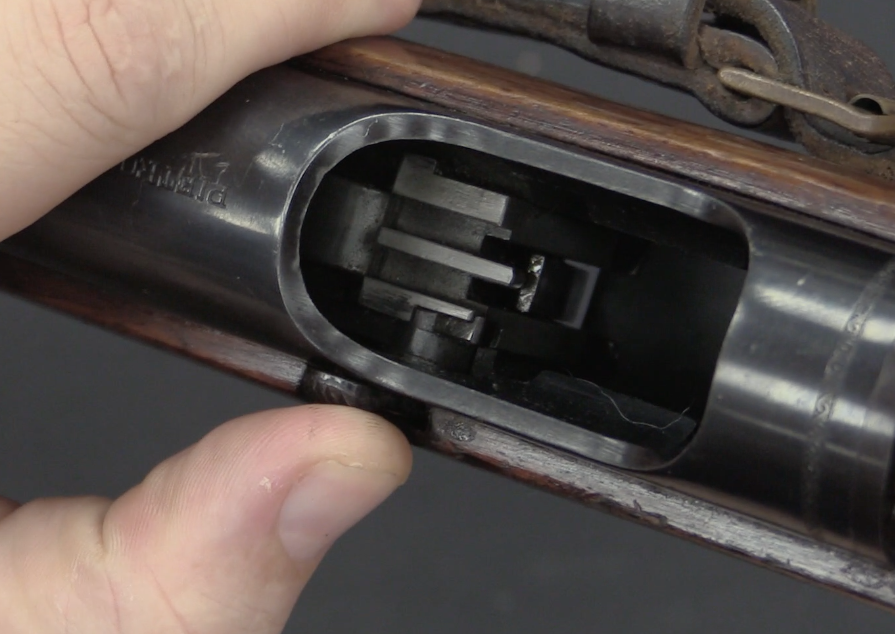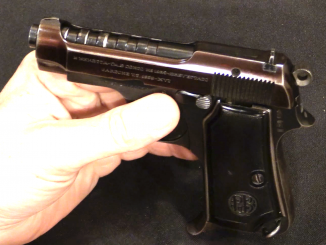One of the problems when trying to learn about rare and unusual firearms (rare and unusual anything, actually) is the lack of primary source material. In other word, information about the gun written by someone with direct experience, not information compiled by a second party. Part of the reason we really like original manuals is that they convey information directly from a gun’s manufacturer, and can almost always be relied upon for accuracy. The same goes for military trials reports, although one must keep in mind potential biases on the part of testing officials.
However, this sort of material is often not available for the really interesting guns, and one if forces to rely on secondhand descriptions whose provenance can’t be determined. It is not uncommon for a writer many decades ago to have mixed up some fact, and then had his mistake repeated by many other authors using him as a source, until you get to the point where the mistake is taken as gospel truth (and recorded as such on Wikipedia).
A perfect example of this is the Italian early selfloading Cei Rigotti rifle. Everyone knows that, being made in Italy, these rifles are chambered for the standard 6.5mm Carcano cartridge. Well, some folks who have access to a Cei Rigotti in the US recently posted this video discussing it, and pointed out that theirs is actually in 7.65×53 Mauser caliber. We have looked at two different examples of the rifle in Europe, and never bothered to look closely at the bores, because hey, everyone knows they’re in 6.5mm. But after seeing that video, we spoke with the Pattern Room curator, who checked and confirmed that their Cei Rigotti is also actually in 7.65×53. The second one we know of is in storage at the moment, but we will be following up to get a confirmation of its actual caliber when it is unpacked.
In retrospect, a 7.65mm chambering would make perfect sense, as the Cei Rigotti was floated to several different countries in hopes of getting a military contract. Carcano ammunition wouldn’t have been widely available outside Italy, but the 7.65×53 was a standard Mauser caliber and would be more readily available and recognizable to potentially interested buyers. The question now is whether all the the Cei Rigottis are in 7.65, or if they were made in two or three different calibers for different markets. We may never be able to know that for sure, since there are only a handful of them still in existence.




Italian researchers might have something to say regarding this. I recall (purely from memory) to have read somewhere about other chamberings, namely 8x50R. The choice of 7.65×53 is curious, since this wasn’t adopted as a standard rifle round by any of the leading powers of the time; Belgium was the main European user. However, it was popular amidst a few South American armies though (mostly Argentina and Peru, but also a few other nations).
Belgium and Latin America – OK, even though the latter were mostly 7×57 countries. But how about Turkey? They were the No.1 user of the 7,65×53 at that time, having more Tufek 90,93 and 98, the Ottomanised M89, M93 and M98 Mausers all chambered for 7,65×53 than Belgium and Argentina combined? We all know Turkey is a 7,9×57 country – but they have turned to this caliber only after the WW1 and big input of German round Gew 88s and Mauser 98s.
And Italy was on the brink of the WW1 effectively a Central Power, along with Germany, Austro-Hungary, Bulgaria and Turkey – so chambering the prototype for caliber used on a huge prospective market of Turkey really made sense.
Italy fought WWi on the side of Britain, France and Russia, resulting in some Carcanos being supplied to Britain (some Arisakas came too).
On hearing the news that Mussolini had allied himself (and supposedly Italy as well*) to Hitler, Churchill is reputed to have said words to the effect of;
“Oh well, It’s only fair that the Germans get Italy on their side this time, we had to put up with them last time”
___________________________________
*many of the Italian population had other ideas
At the start of WWI, Italy was allied with Germany and Austria-Hungary. However, they had an escape clause in their treaty, and initially stayed out of the war. In 1915, they entered the war on the side of Britain, France, and Russia. Italy’s suffering in the war and its aftermath were to a large extent responsible for the rise of the Fascists later.
As for rifle sales, arms was an international business with the emphasis on “business”. At the start of WWI, Britain had two battleships under construction for Turkey. Britain seized both and added them to their own fleet. There would have been nothing unusual about an Italian company attempting to sell rifles to Turkey.
And if those battleships hadn’t been seized, Turkey probably would’ve remained neutral. Bad move on Britain’s part.
Please check what I wrote, not what you read out of it. I didn’t wrote Italy was FIGHTING on the side of Central Powers, but only that they were effectively a Central Power BEFORE the war. It took them more than a year to make up their mind and which side of the fence they were sitting on since 1914 to choose, and then they FOUGHT on Allied side – alongside Japan, by the way. Both Japan and Italy felt themselves shortchanged after 1918, when UK, US and France helped themselves to the remants of the Austro-Hungaria and Turkey – and that’s precisely why they sided with Germany NEXT time.
Thanks for pointing out the Turkish hypothesis, Leszek. I overlooked it and must reckon that it makes sense. And maybe the designer was looking for an alternative manufacturer to build the rifle in large numbers (FN…), hence the caliber choice… I don’t think the Italian factories of the era could effectively cope with large foreign orders.
As for South American (right now, I cannot remember any user of 7,65×53 above the Panama Canal) prospective clients, Argentina was indeed the major user of the 7,65×53, retaining it until at least the early Sixties as their one and only rifle and mg gun round, when it was first complemented and eventually replaced by the 7,62×51.
The Peruvians also used the 7,65×53 (they wanted to use something different from the old enemy to the South, Chile), although they also started to convert some Mauser batches to .30.06 relatively early.
On the other hand, Brazil, as you already implied, was left outside the scope of prospective buyers due to the country’s early adoption of the 7×57, which was retained till quite late, being used alongside the .30.06 for a period after WWII. Anyway, the Brazilian forces were enthusiastic buyers of Mauser rifles and formed quite a lucrative market for the main European manufacturers for some 40 years since the 1890s, as they ordered literally hundreds of thousands of rifles and carbines from German (Loewe, Mauser, DWM), Belgian (FN) and, later on, Czechoslovak sources.
Nice catch!
It’s not only the old wives tales, so many of the easily accessible authors (Smith especially!) never bothered to give source references,
Smith’s lack of referencing is all the more unforgivable given his copying virtually word for word from the likes of Chinn.
another of my many gripes about Smith is his constant smuggling in of own nationalistic prejudices; anything not from the US was a “freak”.
Sorry to rant, but I think several authors (not just Smith) hindered, rather than helped my own search for information.
I have to agree with the importance of primary sources. Very often people will quote some well known writer even if he has long been proven to be wrong. Anything from Wikipedia should also be taken with a very large grain of salt.
However, even primary sources can be wrong when it comes to test results and motivations. Sometimes the reason a firearm or calibre was chosen is due to commercial or political reasons or to line someone’s pocket, but the decision has to be dressed up as “technical” to make it more palatable to the public. Tests can be rigged to give the desired result and requirements can be written to suit a decision that has already been made. That was as true in the past as it is today.
To give you an example, I know of a certain NATO country where the requirements for the current rifle were written by some senior officers who then retired and started a company who just happened to have the manufacturing licenses for the only rifle that met those requirements. That country also sold that rifle to another NATO country in return for buying their radars. Both those countries however would tell you that their decisions were based solely on acquiring the best rifle for their soldiers!
I have always wondered if the real reason why the US wanted the 7.62mm x 51 instead of the 7mm round favoured by Britain, Canada, and Belgium is because they thought they could cheaply convert their existing M1 Garand rifles via a chamber insert. That’s not something you can say to your allies however, so you have to give them a “technical” reason even if they privately suspect otherwise.
P.S. – If you do a Google search for Cei-Rigotti, the second result is a series of images, one if which is Ian holding a Cei-Rigotti rifle!
P.P.S – I assume the Forgotten Weapons article on the Cei-Rigotti will be updated with the new information? Currently, it still says it was 6.5×52 Carcano.
The Garand should’ve been a 7mm rifle in the first place. That was the original design. But that damn fool MacArthur insisted it had to be .30-06 because we already had a bunch of .30-06 ammo stockpiled. If that logic had continued to prevail, we’d never change cartridges.
There is a very similar rant in a recent Arms and the Man (or whatever the NRA collector mag is). I generally ignore that mag because it’s basically just a snob mag for checkbook collectors, but the editor recently teed off on book authors whose only sources are other books, and who write about rare guns and swords from looking at pictures alone.
When I was a kid, footnotes annoyed me. Now the lack of them annoys me. At least once a day I read something about some weapon one of my old units supposedly used, and I have the arms room inventories to prove them wrong. I also hear very strong opinions on the performance of weapons in combat by people who apparently formed those opinions with a playstation controller in hand.
This is an important diagnostic fact for the Cei-Rigotti.
It’s often quoted in technical circles as being the “first” assault rifle, if you retroactively apply the the most rigorous definition to rifles prior to the StG-44, because the 6.5×52 Carcano provides adequate ballistics but recoil comparable to an intermediate cartridge.
However, if all Cei-Rigotti’s were chambered in 7.65×53 Mauser, a much more powerful cartridge, then the term could not be applied to the rifle under the most rigorous definitions, and “automatic rifle” would perhaps be a better description.
I think its safe to assume that there are/were some versions in 6.5 carcano as well.